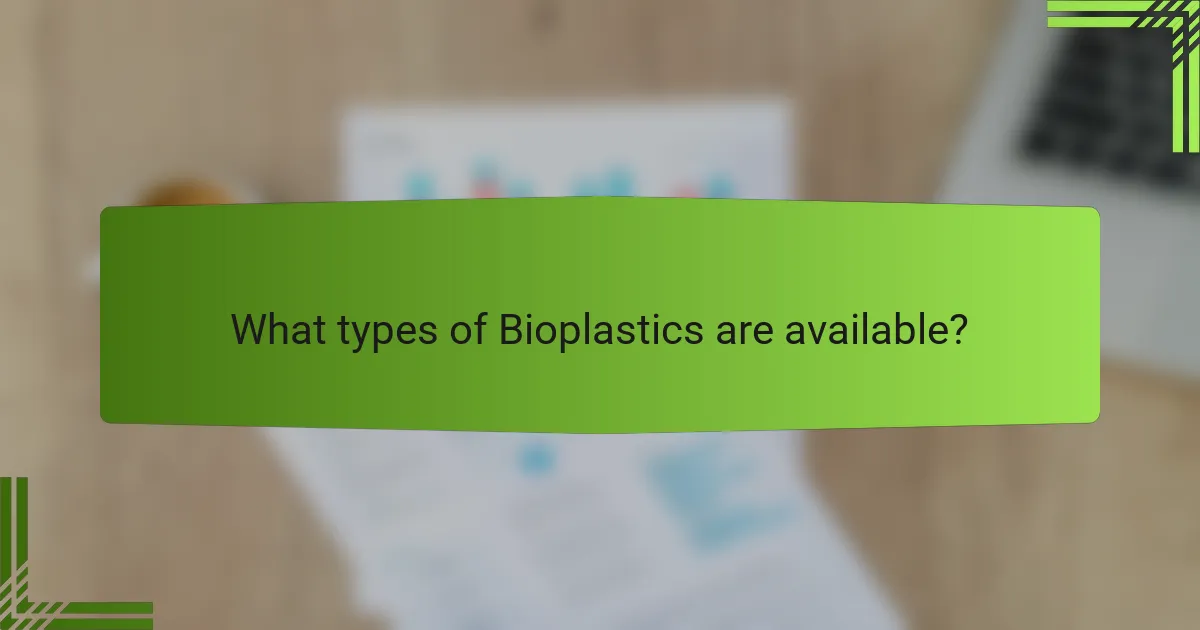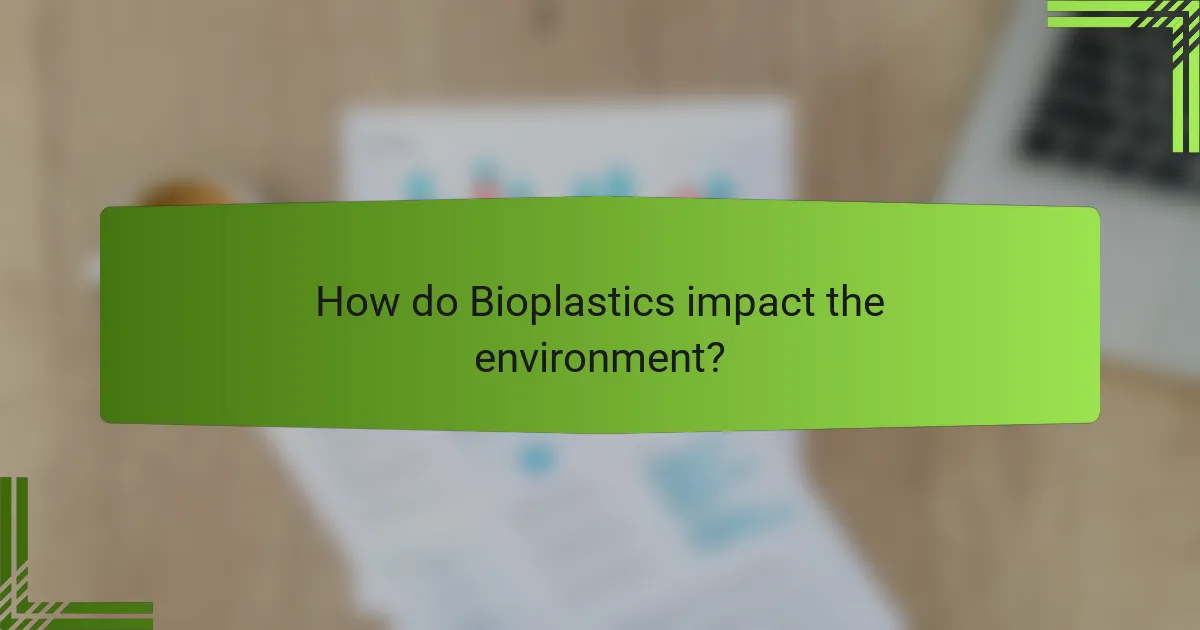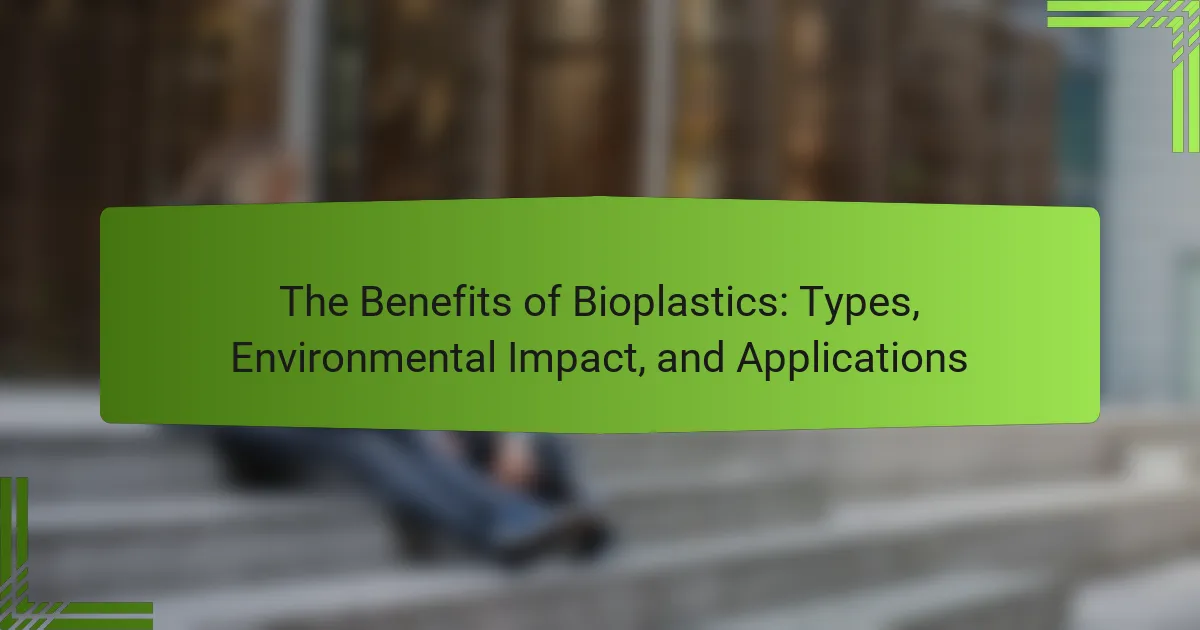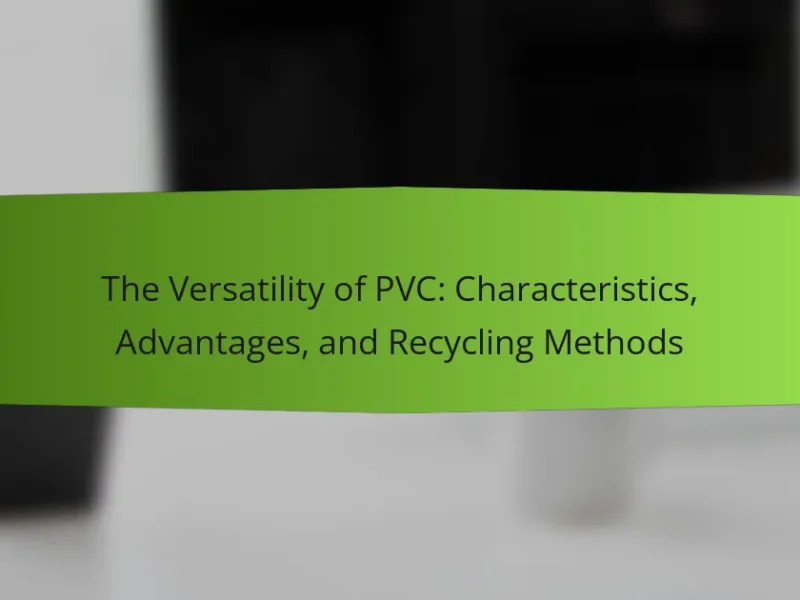Bioplastics are materials made from renewable biomass sources, offering a sustainable alternative to conventional petroleum-based plastics. This article explores the various types of bioplastics, including starch-based, polylactic acid (PLA), polyhydroxyalkanoates (PHA), and cellulose-based bioplastics, each with distinct properties and applications. It also examines the environmental impact of bioplastics, highlighting their potential to reduce fossil fuel dependence, lower greenhouse gas emissions, and minimize plastic waste through biodegradability. Additionally, the article discusses the diverse applications of bioplastics across multiple industries, such as packaging, automotive, medical, agriculture, and consumer goods, underscoring their role in promoting eco-friendly practices.

What are Bioplastics and Why are They Important?
Bioplastics are materials derived from renewable biomass sources, such as plants. They serve as alternatives to conventional plastics, which are petroleum-based. Bioplastics can be biodegradable or non-biodegradable. Their importance lies in reducing reliance on fossil fuels and minimizing plastic waste. For instance, bioplastics can decompose more quickly than traditional plastics, reducing landfill impact. Additionally, they can lower greenhouse gas emissions during production. The global bioplastics market is projected to grow significantly, reaching approximately 6.3 million tons by 2024. This growth indicates a shift towards sustainable materials in various industries.
How do Bioplastics differ from Traditional Plastics?
Bioplastics differ from traditional plastics primarily in their source material. Bioplastics are derived from renewable biomass sources, such as corn starch or sugarcane. Traditional plastics, in contrast, are made from fossil fuels like petroleum. This fundamental difference leads to varying environmental impacts. Bioplastics typically have a lower carbon footprint during production. They can also be biodegradable or compostable, unlike many traditional plastics that persist in the environment for hundreds of years. Research indicates that bioplastics can reduce greenhouse gas emissions by up to 80% compared to conventional plastics. Therefore, the distinction between bioplastics and traditional plastics lies in their material origins and environmental implications.
What are the key characteristics that define Bioplastics?
Bioplastics are defined by their renewable resources and biodegradability. They are derived from biological materials, such as corn starch or sugarcane. This makes them more sustainable than traditional plastics. Bioplastics can also be designed to decompose in natural environments. This characteristic reduces long-term pollution. Additionally, some bioplastics can be recycled, adding to their environmental benefits. They often have similar properties to conventional plastics. This allows for versatile applications in packaging, textiles, and more. These key characteristics highlight bioplastics as a viable alternative to petroleum-based plastics.
Why is the distinction between Bioplastics and Traditional Plastics crucial?
The distinction between bioplastics and traditional plastics is crucial due to their differing environmental impacts. Bioplastics are derived from renewable biomass sources, such as corn or sugarcane. Traditional plastics, on the other hand, are made from fossil fuels. This difference significantly affects their biodegradability. Many bioplastics are designed to decompose more easily in natural environments, reducing long-term waste. In contrast, traditional plastics can take hundreds of years to break down, contributing to pollution. Furthermore, bioplastics can reduce reliance on non-renewable resources. This shift can help mitigate climate change by lowering greenhouse gas emissions. Understanding these distinctions informs consumers and manufacturers about sustainable choices.
What are the main benefits of using Bioplastics?
Bioplastics offer several significant benefits. They are made from renewable resources, reducing reliance on fossil fuels. Bioplastics can biodegrade under the right conditions, minimizing environmental pollution. They often have a lower carbon footprint compared to traditional plastics. Some bioplastics can be composted, returning nutrients to the soil. Their production can lead to less greenhouse gas emissions. Additionally, bioplastics can improve product performance in certain applications. For example, they can provide better moisture barrier properties. These advantages support sustainability and environmental conservation efforts.
How do Bioplastics contribute to environmental sustainability?
Bioplastics contribute to environmental sustainability by reducing reliance on fossil fuels. They are made from renewable resources, such as plant materials. This process lowers greenhouse gas emissions compared to conventional plastics. Bioplastics also have a lower carbon footprint during production. Many bioplastics are biodegradable or compostable. This means they break down more easily in the environment. For instance, polylactic acid (PLA) can decompose within months under industrial composting conditions. Additionally, bioplastics can help reduce plastic pollution in oceans and landfills. Their use promotes a circular economy by encouraging recycling and reuse of materials.
What economic advantages do Bioplastics offer?
Bioplastics offer significant economic advantages including cost savings in production and reduced waste management expenses. Their production often utilizes renewable resources, which can lead to lower raw material costs over time. Bioplastics can also reduce dependency on fossil fuels, potentially stabilizing prices against market fluctuations. Furthermore, they often require less energy to produce compared to conventional plastics, contributing to lower manufacturing costs. According to a study by the European Bioplastics Association, bioplastics can create new market opportunities and jobs in the green economy. Additionally, bioplastics can enhance brand reputation, attracting eco-conscious consumers and potentially increasing sales.

What types of Bioplastics are available?
There are several types of bioplastics available. The main categories include starch-based bioplastics, polylactic acid (PLA), polyhydroxyalkanoates (PHA), and cellulose-based bioplastics. Starch-based bioplastics are derived from renewable resources like corn and potatoes. PLA is made from fermented plant starch and is compostable under industrial conditions. PHA is produced by microbial fermentation and is biodegradable in various environments. Cellulose-based bioplastics come from plant cellulose and offer good mechanical properties. Each type has unique properties and applications in packaging, agriculture, and consumer goods.
What are the different categories of Bioplastics?
Bioplastics can be categorized into two main types: bio-based and biodegradable plastics. Bio-based plastics are derived from renewable biological sources, such as corn starch or sugarcane. They can be designed to be either biodegradable or non-biodegradable. Biodegradable plastics, on the other hand, are designed to decompose through natural processes, often using microorganisms. Some biodegradable plastics are also bio-based, while others are petroleum-based. This classification helps in understanding their environmental impact and applications.
How are Starch-based Bioplastics produced and utilized?
Starch-based bioplastics are produced through the processing of starch, which is derived from renewable sources like corn, potatoes, or tapioca. The production involves gelatinization, where starch granules are heated in water, causing them to swell and dissolve. This process creates a viscous solution that can be molded into various shapes. After cooling, the starch can be blended with plasticizers to enhance flexibility and durability.
Utilization of starch-based bioplastics is widespread in packaging, disposable cutlery, and agricultural films. These bioplastics are biodegradable, making them an eco-friendly alternative to traditional plastics. Their compostability contributes to reducing plastic waste in landfills. Studies show that starch-based bioplastics can decompose within months under proper conditions, unlike conventional plastics that take hundreds of years.
What are the properties and uses of PLA (Polylactic Acid)?
PLA (Polylactic Acid) is a biodegradable thermoplastic made from renewable resources. It has properties such as high tensile strength, low thermal conductivity, and a melting point of around 150-160°C. PLA is transparent and has a glossy finish, making it suitable for various applications. It is commonly used in 3D printing, packaging materials, and disposable cutlery. PLA degrades into lactic acid under industrial composting conditions, thus reducing environmental impact. Studies show that PLA can break down in 60-90 days in composting environments. Its renewable origin and biodegradability make it a popular choice in sustainable materials.
What are the unique attributes of various Bioplastic types?
Bioplastics exhibit unique attributes based on their type. PLA (Polylactic Acid) is derived from renewable resources like corn starch. It is compostable and has a low carbon footprint. PHA (Polyhydroxyalkanoates) is produced by microorganisms and is biodegradable in marine environments. Starch-based bioplastics are made from natural starch and are often used for packaging. Cellulose-based bioplastics are derived from plant cellulose and are known for their transparency and flexibility. Each type serves specific applications, enhancing sustainability in various industries.
How does the biodegradability of different Bioplastics vary?
The biodegradability of different bioplastics varies significantly based on their composition and structure. Polylactic acid (PLA) bioplastics typically biodegrade within a few months under industrial composting conditions. In contrast, polyhydroxyalkanoates (PHA) can biodegrade in marine environments, taking several weeks to months. Starch-based bioplastics also exhibit varying biodegradability, often breaking down within a few months in composting environments. The presence of additives and the specific formulation of the bioplastic influence the rate of biodegradation. Research indicates that while some bioplastics are designed for rapid degradation, others may take years if not exposed to optimal conditions. The variation in biodegradability is crucial for determining their environmental impact.
What are the performance characteristics of each Bioplastic type?
Bioplastics can be categorized into several types, each with distinct performance characteristics. PLA (Polylactic Acid) is biodegradable and has good clarity and rigidity. It is suitable for applications like food packaging. PHA (Polyhydroxyalkanoates) is also biodegradable and exhibits flexibility, making it ideal for medical applications. Starch-based bioplastics are compostable and have low mechanical strength, often used in disposable items. PBS (Polybutylene Succinate) has good thermal stability and is biodegradable, suitable for packaging and agricultural films. Each type’s specific properties dictate its applications and environmental benefits.

How do Bioplastics impact the environment?
Bioplastics impact the environment by reducing reliance on fossil fuels and decreasing greenhouse gas emissions. They are derived from renewable resources, such as corn or sugarcane. This shift helps to lower carbon footprints compared to conventional plastics. Bioplastics can also be biodegradable or compostable, leading to less plastic waste in landfills. For instance, studies show that certain bioplastics can decompose within months under the right conditions. However, the environmental benefits vary depending on the type of bioplastic and its production process. Some bioplastics still require significant energy and water for cultivation. Overall, while bioplastics offer advantages, their environmental impact must be assessed on a case-by-case basis.
What are the environmental benefits of Bioplastics?
Bioplastics offer significant environmental benefits. They are derived from renewable resources, reducing dependency on fossil fuels. Bioplastics typically have a lower carbon footprint compared to traditional plastics. They can biodegrade more easily, minimizing landfill waste. Studies show that certain bioplastics can decompose in industrial composting conditions within months. This reduces long-term environmental pollution. Additionally, bioplastics can help in reducing greenhouse gas emissions during production. Their use promotes a circular economy by allowing for resource recovery and recycling.
How do Bioplastics reduce carbon footprint compared to traditional plastics?
Bioplastics reduce carbon footprint compared to traditional plastics by utilizing renewable resources. They are derived from plant materials such as corn or sugarcane. This process captures carbon dioxide from the atmosphere during plant growth. Traditional plastics, in contrast, are made from fossil fuels, releasing stored carbon when produced. Bioplastics can also biodegrade more easily, reducing long-term environmental impact. Studies show that bioplastics can lower greenhouse gas emissions by up to 70% compared to conventional plastics. This significant reduction is due to the lifecycle emissions associated with their production and disposal.
What role do Bioplastics play in waste management and reduction?
Bioplastics play a significant role in waste management and reduction by being biodegradable and compostable. Unlike conventional plastics, bioplastics can break down more easily in natural environments. This property helps reduce plastic waste accumulation in landfills and oceans. According to a study by the European Bioplastics Association, bioplastics can reduce greenhouse gas emissions by up to 80% compared to fossil-based plastics. Additionally, their use in packaging can lead to a decrease in single-use plastic consumption. Bioplastics can also be produced from renewable resources, further supporting sustainable waste management practices. This shift contributes to a circular economy, minimizing environmental impact.
What challenges do Bioplastics face in terms of environmental impact?
Bioplastics face several challenges regarding their environmental impact. One significant issue is the competition for agricultural resources. Bioplastics often require crops that could otherwise be used for food production. This can lead to food scarcity and higher prices.
Another challenge is the biodegradability of certain bioplastics. While some bioplastics are marketed as biodegradable, they may only decompose under specific industrial conditions. In natural environments, they can persist for long periods, contributing to pollution.
Moreover, the production process of bioplastics can still generate greenhouse gas emissions. Although they are derived from renewable resources, the cultivation, harvesting, and processing can have a carbon footprint.
Lastly, waste management systems are not always equipped to handle bioplastics. Many recycling facilities do not accept them, leading to increased landfill contributions. These factors highlight the complexity of bioplastics’ environmental impact.
How do production methods affect the sustainability of Bioplastics?
Production methods significantly influence the sustainability of bioplastics. Different methods can determine the environmental impact and resource utilization. For instance, fermentation-based production typically uses renewable biomass, leading to lower carbon footprints. In contrast, fossil fuel-derived methods increase greenhouse gas emissions. Additionally, the choice of feedstock affects land use and biodiversity. Sustainable practices, such as using agricultural waste, minimize resource depletion. Research indicates that bioplastics produced from renewable sources can reduce reliance on fossil fuels by up to 70%. Furthermore, efficient production techniques can enhance biodegradability, promoting environmental benefits.
What are the limitations of Bioplastics in the current market?
Bioplastics have several limitations in the current market. Their production often requires more energy compared to traditional plastics. This can offset some of the environmental benefits. Bioplastics can also be more expensive to produce. The cost can deter manufacturers from switching from conventional plastics. Additionally, the mechanical properties of bioplastics may not match those of traditional plastics. This limits their applications in certain industries. Biodegradability is another concern. Not all bioplastics decompose under typical environmental conditions. Lastly, the availability of raw materials can be inconsistent. This affects the supply chain and production scalability.

What are the applications of Bioplastics in various industries?
Bioplastics have diverse applications across various industries. In packaging, they are used for biodegradable bags and food containers. The automotive industry employs bioplastics for interior components and dashboards. In the medical field, bioplastics serve in disposable syringes and implants. Agriculture utilizes bioplastics for mulch films and plant pots. Consumer goods, such as utensils and toys, are also made from bioplastics. The construction sector incorporates bioplastics in insulation materials and piping. These applications highlight the versatility and eco-friendliness of bioplastics in replacing traditional plastics.
How are Bioplastics utilized in packaging?
Bioplastics are utilized in packaging as sustainable alternatives to traditional plastics. They are derived from renewable sources like corn starch or sugarcane. This reduces reliance on fossil fuels. Bioplastics can be compostable or biodegradable. They break down more easily in the environment compared to conventional plastics. For example, polylactic acid (PLA) is a common bioplastic used in food packaging. Studies show that using bioplastics can significantly lower greenhouse gas emissions. The European Bioplastics Association reported that bioplastics can reduce carbon footprints by up to 80%.
What innovations are driving the use of Bioplastics in food packaging?
Innovations driving the use of bioplastics in food packaging include advancements in material science and bioengineering. These innovations lead to the development of bioplastics derived from renewable resources like corn starch and sugarcane. Enhanced biodegradability is a significant focus, allowing bioplastics to break down more quickly in natural environments. Improved barrier properties are also being achieved, which help preserve food freshness and reduce spoilage. Additionally, innovations in processing techniques enable the production of bioplastics that are more cost-effective and scalable. Research shows that bioplastics can reduce carbon footprints by up to 70% compared to traditional plastics. These advancements collectively support the growing demand for sustainable packaging solutions in the food industry.
How do Bioplastics enhance sustainability in consumer goods packaging?
Bioplastics enhance sustainability in consumer goods packaging by reducing reliance on fossil fuels. They are derived from renewable resources such as corn starch, sugarcane, or vegetable oils. This shift lowers greenhouse gas emissions associated with traditional plastic production. Bioplastics also tend to be biodegradable or compostable, which aids in waste management. According to a study by the European Bioplastics Association, bioplastics can reduce carbon footprints by up to 80% compared to conventional plastics. Additionally, they can help minimize plastic pollution in oceans and landfills. This makes bioplastics a more sustainable option for packaging solutions in the consumer goods sector.
What other industries are adopting Bioplastics?
The automotive industry is adopting bioplastics for lightweight components. Bioplastics help reduce vehicle weight, improving fuel efficiency. The packaging industry also embraces bioplastics for sustainable packaging solutions. Products made from bioplastics are biodegradable and reduce plastic waste. The textile industry uses bioplastics in fibers for eco-friendly clothing. Bioplastics offer a renewable alternative to traditional synthetic fibers. The consumer goods sector incorporates bioplastics in everyday products. This shift supports sustainability and reduces reliance on fossil fuels.
In what ways are Bioplastics being used in the automotive industry?
Bioplastics are being used in the automotive industry primarily for interior components, exterior parts, and lightweight applications. They replace traditional plastics in dashboards, door panels, and seat coverings. This substitution reduces the overall weight of vehicles, improving fuel efficiency. Bioplastics also provide a lower environmental impact due to their renewable origins. In addition, they can be designed to meet specific performance standards, such as impact resistance and durability. Companies like BMW and Ford have integrated bioplastics into their manufacturing processes. For instance, BMW utilizes bioplastics made from renewable resources in various vehicle interiors. These applications demonstrate the growing trend of sustainability in automotive design.
How are Bioplastics integrated into healthcare and medical devices?
Bioplastics are increasingly integrated into healthcare and medical devices due to their biocompatibility and sustainability. They are used in applications such as drug delivery systems, sutures, and prosthetics. Bioplastics like polylactic acid (PLA) and polyhydroxyalkanoates (PHA) are designed to be safe for human use. These materials can degrade naturally, reducing environmental impact. Research indicates that bioplastics can effectively replace conventional plastics in many medical applications. For example, a study published in “Biomaterials” highlights the potential of PLA in tissue engineering. Bioplastics also offer customization options for specific medical requirements. Their integration supports both patient safety and environmental sustainability.
What best practices should industries follow when implementing Bioplastics?
Industries should prioritize sustainability when implementing bioplastics. This includes sourcing renewable raw materials, such as corn or sugarcane. They should also ensure that bioplastics are designed for compostability or recyclability. Proper labeling is essential to inform consumers about the product’s environmental benefits. Collaborating with supply chain partners enhances the efficiency of bioplastic production. Conducting lifecycle assessments helps industries understand the environmental impact. Training employees on bioplastic properties and applications is crucial. Finally, staying updated on regulations and standards ensures compliance and promotes best practices.
How can companies effectively transition to using Bioplastics?
Companies can effectively transition to using bioplastics by conducting a thorough assessment of their current materials and processes. This involves evaluating the environmental impact of existing plastics. Next, they should identify suitable bioplastic alternatives that meet their product requirements. Engaging with suppliers who specialize in bioplastics is crucial for sourcing materials. Additionally, companies must invest in employee training to understand bioplastic properties and applications. Testing and prototyping new products with bioplastics can help refine processes. Collaborating with industry partners can facilitate knowledge sharing and innovation. Lastly, companies should communicate their sustainability goals to consumers, enhancing brand reputation.
What considerations should be made for sourcing and manufacturing with Bioplastics?
Sourcing and manufacturing with bioplastics require careful consideration of material origin, production processes, and environmental impact. Selecting renewable feedstocks is crucial, as bioplastics derive from natural resources like corn or sugarcane. The sustainability of these resources affects their environmental footprint. Manufacturing methods should minimize energy consumption and waste generation. Additionally, ensuring compatibility with existing recycling systems is vital for effective waste management. Certifications for sustainability can enhance credibility and market acceptance. Compliance with regulations and standards is also necessary to ensure safety and quality. These considerations help maximize the benefits of bioplastics while minimizing their drawbacks.
Bioplastics are sustainable materials derived from renewable biomass sources, offering an alternative to traditional petroleum-based plastics. This article explores the various types of bioplastics, their environmental impact, and their applications across multiple industries, highlighting their benefits such as biodegradability, reduced carbon footprint, and versatility. Key sections include the differences between bioplastics and traditional plastics, their characteristics, economic advantages, and specific uses in packaging, automotive, and healthcare sectors. Additionally, the article addresses challenges facing bioplastics and best practices for their implementation in various industries.


